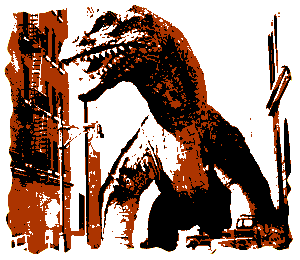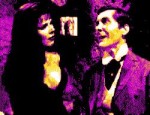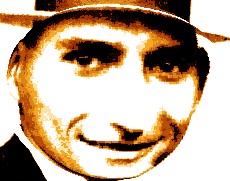Film Review
Amidst the wave of paranoia and pessimism that accompanied the early
years of the Cold War cinema screens were showered with a seemingly
endless torrent of monster movies which did their best to exploit
public apprehension of a real threat whilst providing the starkest of
visual metaphors for the Atomic Age - a terrible destructive
monstrosity unleashed on mankind as a result of his foolish tampering
with nature.
The Beast from 20,000 Fathoms was the film that set this particular apocalyptic
band wagon rolling, a classic of its genre that would prove hugely
influential, thanks to its groundbreaking special effects provided by
effects wizard Ray Harryhausen.
It was independent producer Jack Dietz who conceived the film, hoping to cash in on the box
office stampede that ensued when RKO re-released its
King
Kong (1933) in 1951. He and Hal E. Chester concocted a
storyline which, as luck would have it, bore a striking similarity to
one that Ray Bradbury had recently written -
The Fog Horn, first published in
The Saturday Evening Post in
1951. For a modest fee, Bradbury gave his consent for Dietz and
Chester to use his story, which would provide the film with its most
iconic scene - the one where the fierce rhedosaurus attacks a solitary
lighthouse. Harryhausen was drafted in to work on the effects,
his first solo assignment after assisting Willis O'Brien (the genius
behind the effects on
King Kong)
on
Mighty Joe Young (1949).
Lacking the funds to create detailed miniature sets as O'Brien had done
on his films, Harryhausen had to come up with a cost-effective
alternative, a split-screen refinement of O'Brien's stop-motion
animation technique that he termed
Dynamation.
This involved separating the foreground and background of a previously
filmed live-action shot and projecting the background part of the shot
onto a small screen in front of which the flexible model of the monster
could be manipulated, frame by frame. Once the model sequence had
been shot, this was then re-combined with the foreground part of the
live-action shot, using conventional matting techniques. The
result is the apparently seamless insertion of the animated monster
into the original filmed footage. The technique was so successful
that Harryhausen would employ it on subsequent films, resulting in a
quantum leap in both the quality and degree of exploitation of
stop-motion animation by the mid-1950s. Had its central
prehistoric monster not been so convincingly realised,
The Beast from 20,000 Fathoms would
have been just another run-of-the-mill B-movie. What makes the
film so exciting and so compelling, even to this day, is the fact that
the rhedosaurus has such a real and menacing presence - and also a
strangely endearing quality which compels some degree of sympathy, even
when it is happily chewing up most of Manhattan.
Ray Harryhausen deserves a fair share of the credit for the film's
success, but so does its director Eugène Lourié, a
Frenchman making his directing debut after recently working as art
director on Charlie Chaplin's
Limelight (1952) and production
designer on Jean Renoir's
The River (1951). Before
moving to Hollywood, Lourié was one of France's most highly
regarded art directors, working not only with Renoir on such films as
La Grand illusion (1937) and
La
Règle du jeu (1939), but also with such revered
cineastes as Abel Gance, Marcel L'Herbier and Max Ophüls.
The success of
The Beast from 20,000
Fathoms proved to be Eugène Lourié's undoing - the
only two other films he directed were also monster movies,
Behemoth the Sea Monster (1959) and
Gorgo (1961). In the
twilight of his career, he received an Oscar nomination for his effects
work on
Krakatoa, East of Java (1969).
Lourié's experience as an art director no doubt accounts for
Beast's striking visuals, which are
some of the most impressive to be found in any monster movie and
doubtless inspired future directors in the genre. The sequence of
the rhedosaurus running amok in New York is extraordinary, in both its
ambition and realism, for a film of this era.
Once the film was in the can Jack Dietz was sure it was hot property
and started looking for a buyer. He sold it on to Warner Brothers
for a sum of 400 thousand dollars, making a tidy profit of 150 thousand
dollars. Not the wisest of commercial movies as it turned
out. With some aggressive marketing behind it,
The Beast from 20,000 Fathoms ended
up making five million dollars for Warners - it was the biggest box
office hit of the year. The film's success quickly spawned a
succession of similar monster offerings featuring all manner of
over-sized monstrosities, from gigantic reptiles to leviathan sea
creatures. Warner Brothers'
Them! (1954) started a craze
for movies featuring giant insects, and
Gojira (1954), made by the Japanese
studio Toho, saw Godzilla make his first appearance. As it fed on
our deeper neuroses, cinema suddenly became a scarier and gloomier
place - just as the world outside had become as America and the Soviet
Union went on stockpiling nuclear weapons like there was no tomorrow.
© James Travers 2015
The above content is owned by frenchfilms.org and must not be copied.



